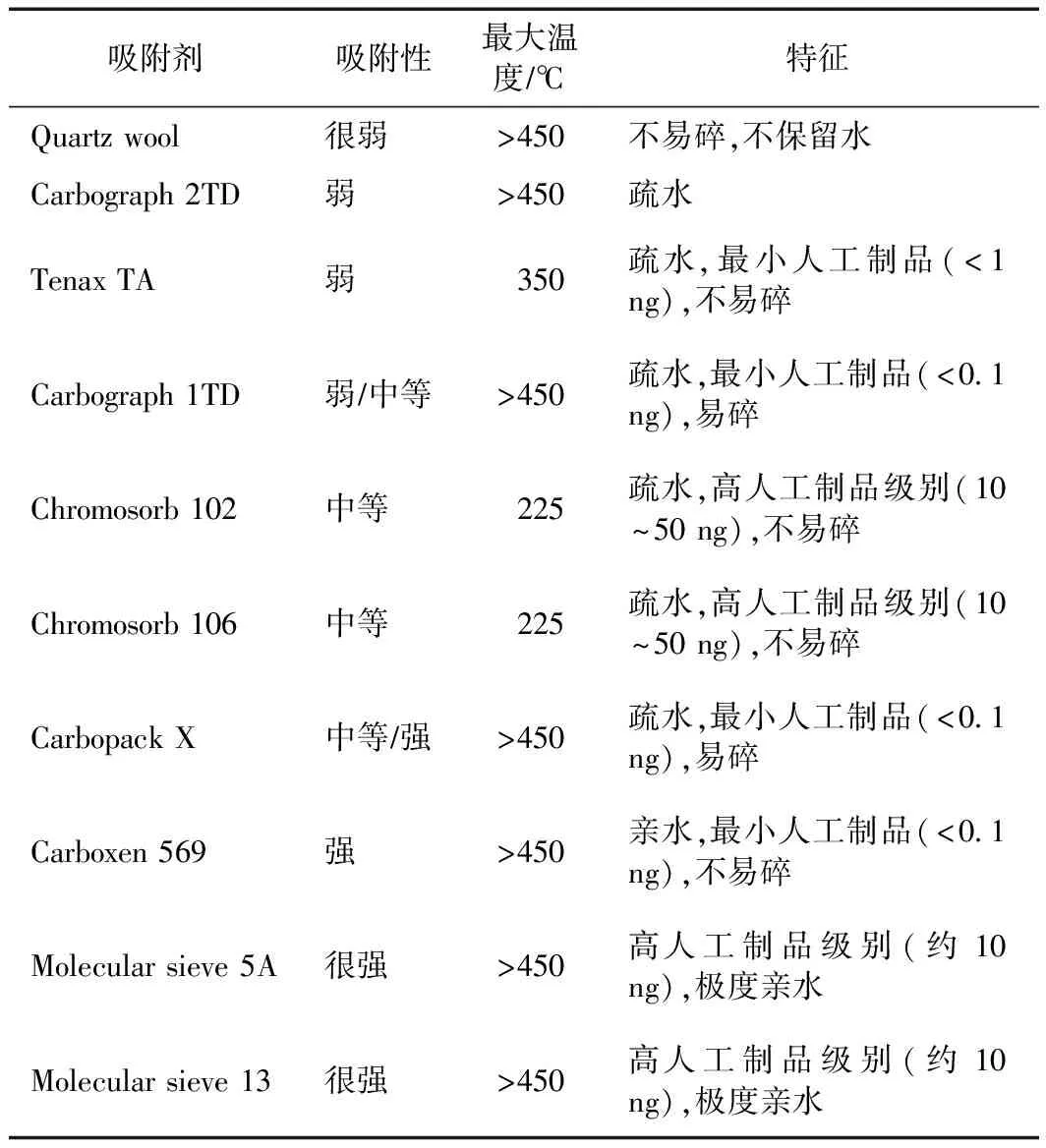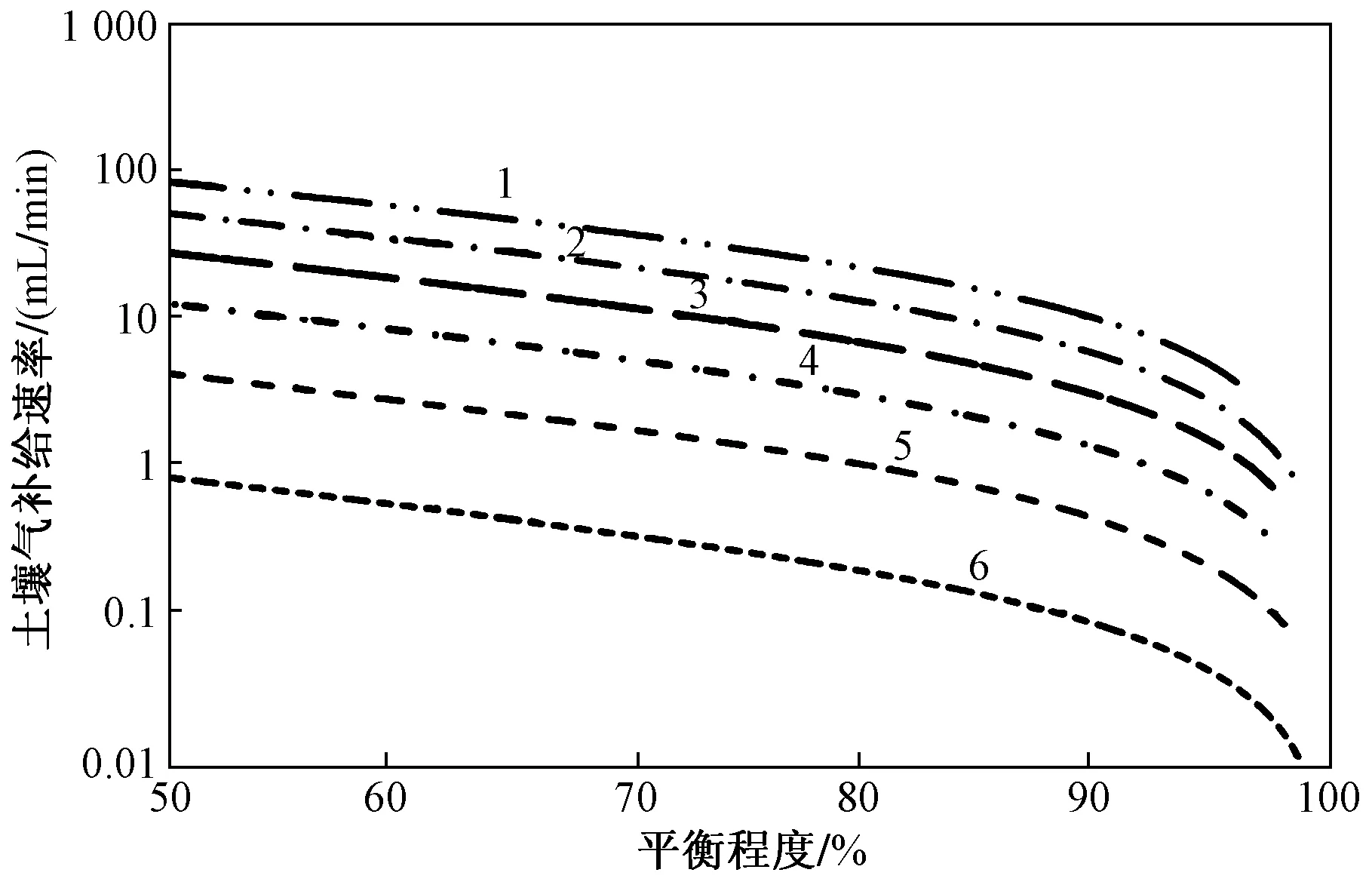污染场地土壤气中VOCs定量被动采样技术研究及应用
姜 林, 赵 莹, 钟茂生, 付全凯
1.北京市环境保护科学研究院, 北京 100037 2.国家城市环境污染控制工程技术研究中心, 北京 100037 3.污染场地风险模拟与修复北京市重点实验室, 北京 100037
污染场地土壤气中VOCs定量被动采样技术研究及应用
姜 林1,2,3, 赵 莹1,2,3, 钟茂生1,2,3, 付全凯1,2,3
1.北京市环境保护科学研究院, 北京 100037 2.国家城市环境污染控制工程技术研究中心, 北京 100037 3.污染场地风险模拟与修复北京市重点实验室, 北京 100037
污染场地中土壤气样品的采集是蒸气入侵风险评估的关键,目前最常用的主动土壤气采集技术包括真空苏玛罐和泵吸附管,其操作繁琐、成本高、易受多种因素影响、只能采集短时间的浓度. 土壤气定量被动采样技术是一种新兴的采样技术,很好地克服了主动式采样存在的不足,是目前污染场地中土壤气调查的研究热点. 通过总结现有研究,就定量被动采样技术的理论、被动采样器吸附剂和外壳材料的选择、被动采样器吸附速率的研究及定量被动采样在污染场地中的应用进行论述. 综合研究发现,只要严格控制吸附速率,被动采样能够提供准确的定量土壤气浓度测量;采样器结构的设计、外壳材料的选择能够有效控制吸附速率;吸附速率受环境因素和土壤性质的影响,场地校正是获得准确结果的有效途径. 我国在土壤气采样领域的研究刚刚起步,建议:加大高效、广谱型或混合型吸附材料及相应测试方法和设备的研发;加强吸附速率的影响因子及场地校准方法的研究;加强土壤钻孔内土壤气的补给速率的模型和场地实测研究;增加不同种采样器的现场应用比较研究;进行适合我国国情的技术标准的研究与制订.
污染场地; 土壤气; 挥发性有机物; 被动采样
由于生产期间污染防治措施不到位,一些化工、炼化、焦化等企业原厂址土壤和地下水已受到严重污染,其中VOCs(挥发性有机物)是典型污染物之一[1-2]. 这些场地在进行开发前需进行调查与评估,以确定是否会对未来使用人群的健康造成不可接受的风险. 我国场地调查与风险评估推荐采集土壤或地下水中VOCs的含量,采用三相平衡模型计算VOCs在土壤固相与气相间的分配,评估VOCs场地蒸气入侵暴露途径健康风险. 国内外已有大量研究[3-6]表明其评估结果过于保守,为此欧美国家已开始基于土壤气中VOCs实测质量浓度进行评估[7]. 美国Interstate Technology & Regulatory Council (ITRC)蒸气入侵指南[8]指出“相比测试土壤和地下水中污染物浓度,测试土壤气中目标污染物浓度更能表征其蒸气入侵的风险”. 目前土壤气采样技术以主动式采样为主,可分为真空Summa罐采样法及“真空泵+吸附管”采样法. 真空Summa罐法主要是将Summa罐与采样导管链接,利用Summa罐的负压,将污染物抽吸至不锈钢罐内[9-12];“真空泵+吸附管法”主要是通过抽提将土壤气以一定的流速流经装有单种或者多种吸附材料的吸附管,通过吸附管中吸附材料的吸附作用,将特定的污染物吸附富集[13]. 土壤气的主动采样技术在低渗透性、高含水率的污染场地中应用受阻,并且该采样技术成本过高,采样过程复杂、容易受多种因素的干扰、只能采集瞬时样品,不能很好反映土壤气VOCs浓度在时间上变异较大的特征[14-16]. 相比于主动采样,被动采样技术方法简单、不需要外力、能够采集时间加权的浓度、适用于各种土壤类型的土壤气调查,在多点采样、边缘地带采样、长期采样等方面更有应用前景.
被动采样技术的研究具有较长的历史,20世纪40年代被动采样首次应用于人体骨骼中镉的生物富集,50年代被动采样技术被应用于鱼类中甲基汞的生物富集,60年代应用被动采样技术对牡蛎中的三丁基锡进行了生物富集的研究,70年代被动采样器首次被应用于环境空气和室内空气中污染物的采集,80年代被动采样技术被应用于水体中污染物的富集,90年代首次使用对土壤中污染物进行采集[17],目前应用已经涉及到环境空气、室内空气、水体、土壤、沉积物[18-23]等环境领域. 早期土壤气的被动采样由于测量结果是质量,不能很好地转化为浓度,通常被认为是一种定性或半定量的方法,但是,近些年土壤气定量被动采样逐渐成为污染场地调查中的研究热点.
该研究针对土壤气定量被动采样技术的理论、吸附剂和外壳材料的选择、吸附速率的影响因素、定量被动采样器在污染场地调查中的应用等方面进行系统介绍,并结合国内研究现状进行展望,以期为我国土壤气定量被动采样的研究、应用及标准的制订提供参考.
1 定量被动采样技术理论
定量土壤气被动采样器设计主要依据Fick定律,利用目标污染物在土壤气介质以及采样器内吸附介质间的浓度梯度,使目标污染物通过分子扩散被吸附到采样器的吸附介质上. 采用热脱附或者溶剂提取对目标污染物进行解吸,并通过GC-FID或GC-MS进行定量分析[17,24]. Fick定律用公式可简述为

(1)
式中:m为吸附剂吸附的污染物的质量,μg;t为采样时间,s;A是扩散路径的横截面积,cm2;D为污染物的扩散速率,cm2s;Ca为土壤气介质中的污染物的浓度,μgcm3;Cf为吸附剂界面上的污染物的浓度,μgcm3,理想情况下假设为0;L为扩散路径的长度,cm.
假设吸附剂为理想状态,即Cf为0,则式(1)简化为

(2)
2 被动采样器吸附剂和外壳材料选择
被动采样器吸附剂的选择原则是既要保证吸附剂对目标污染物有很好的保留作用,同时在分析时易于目标污染物的脱附解吸[29]. 吸附剂与目标污染物间结合能力弱会导致反扩散的出现,致使测量浓度降低[30-31];同时长时间采样会放大水蒸气和其他VOCs的竞争作用. 相反,吸附剂与目标污染物的吸附结合能力强,不易于目标污染物的脱附解吸,同样导致测量结果偏低[32]. 被动采样器吸附剂中目标污染物的解吸方法目前主要有溶剂提取和热脱附. 溶剂提取(如二硫化碳提取)不仅会危害试验人员的健康,也会干扰随后的色谱分析[33],该方法适用于活性炭、硅胶、分子筛等强吸附剂的解吸分析[32,34]. 热脱附不仅大幅度提高分析灵敏度同时能够实现自动化,减少操作过程中人为误差的影响,适用于Tenax TA、Carbopack B等弱吸附剂的解吸分析[32]. Woolfenden[29]提出,采用热脱附时吸附剂的选择应考虑吸附剂与目标物之间的作用强度、尺寸、热稳定性、疏水性、惰性和机械强度等因素,并对常见吸附剂的性能进行了总结(见表1). 环境空气领域吸附剂的选择原则同样适用于土壤气领域,土壤气的湿度近似100%,需要更加注重吸附剂的疏水性[35]. 目前,EPA 8260已对被动采样中VOCs的分析测试方法进行相应规范,国内虽有VOCs的分析测试方法HJ 605,但是尚无相应的前处理方法,土壤气被动采样前处理方法及其标准体系的建立是推广其应用的重要条件.

表1 常用的适用于热脱附的吸附剂[29]
被动采样器由吸附剂和起保护或者支撑作用的外壳组成. 外壳材料选择主要考虑减少环境因素(如水分)对吸附剂的影响,保证被动采样器能够有稳定的吸附速率. 被动采样器依据外壳材料的不同可分为扩散采样器和渗透采样器[36]. 早期外壳主要采用聚氨酯泡沫塑料、聚乙烯等多孔扩散性材料,不能有效减缓外界环境因素对采样器吸附速率的影响,主要用于空气领域污染物的采集[37-38]. 20世纪80年代后,广泛采用硅凝胶、聚二甲硅氧烷、聚乙烯等无孔膜渗透性材料,可有效降低外界环境因素的影响,主要用于水体、空气、底泥等污染物的被动采集[39-42]. 新型外壳材料的研发是确保被动采样器吸附速率恒定的关键,是今后的研究重点.
3 被动采样器吸附速率的研究
3.1被动采样器结构对吸附速率的影响
被动采样器扩散路径的长度和横截面积决定采样器吸附速率的大小[17,24]. 商品化的被动采样器根据结构不同可分为径向扩散采样器及轴向扩散采样器两种[43],轴向扩散采样器包括管型被动采样器(如Drager ORSA采样器)和徽章型被动采样器(如SKC采样器),径向扩散采样器的典型代表为Radiello采样器(见图1). 管型被动采样器扩散路径的长度最长、横截表面最小,因此吸附速率相对最低. 徽章型采样器扩散路径的长度更短、横截面积更大,因此吸附速率大于管型采样器. 径向采样器扩散路径的长度最短、横截面积最大,因此吸附速率最大[32]. Sigma-Aldrich公司研究发现,扩散路径的横截面积与长度的比值相同时,径向扩散采样器的吸附速率比轴向扩散采样器要大,且轴向扩散采样器的吸附速率随比值的增加呈线性增加,而径向采样器的吸附速率随比值的增加呈指数增加(见图2)[44].

图1 被动采样器结构[32]Fig.1 The structure of passive sampler

图2 轴向和径向采样器吸附速率比较[44]Fig.2 Radial-axial passive sampler comparison in uptake rate
3.2环境因素对吸附速率的影响
被动采样器吸附速率的主要影响因素有温度、湿度、风速[45],目前尚无开展系统研究,并且现有研究结论差异较大. 清华大学DU等研究发现,Tsinghua Passive Diffusive Sampler在测量苯、甲苯、二甲苯时分别存在21.5%、23.3%和16.9%的不确定性[46],吸附速率是影响定量被动采样结果准确性的主要因素,定量采样结果不确定性的80%是由吸附速率的变化导致的[47]. 环境空气领域中一些研究发现,被动采样器对目标污染物的吸附速率不受浓度、湿度和风速的影响,却受到温度的影响,并且试验测得的吸附速率是理论值的1/3[48-49]. 另一些研究[49-50]发现,Perkin-Elmer管被动采样器对苯和甲苯的吸附速率会随着暴露剂量的增加而降低. 不同试验间的差异是由于吸附剂强弱、外壳结构保护作用强弱等引起. Mcalary等[51]的场地试验研究显示,被动采样过程中吸附速率会受到场地条件的影响,如采样时间和钻孔体积,故开展污染场地中实际场地参数对吸附速率的校正研究将是定量被动采样的一个重点研究方向[52-53].
3.3土壤性质对吸附速率的影响
土壤性质直接影响土壤气在土壤中的扩散速率,间接影响被动采样器吸附速率的选择. Mcalary等[54]研究发现,周围土壤气向钻孔内的补给速率(DDR)受有效扩散系数的影响,即土壤孔隙度和含水率会影响土壤气向钻孔内的补给速率. 同时,在被动采样过程中,当土壤钻孔内被动采样器对目标污染物的吸附速率(UR)大于周围土壤气中目标污染物向钻孔内的补给速率时,会导致采样器周围土壤气浓度局部降低,进而导致测量浓度偏低,此现象称为饥饿效应. Mcalary等[54]采用土壤钻孔内径向蒸气扩散的动态与静态数学模型,推导出包气带中含水孔隙度在0.05~0.30时土壤气补给速率(DDR)(见图3)为0.1~1 mL/min,理论上说明低吸附速率被动采样器(吸附速率在0.1~1 mL/min)能够有效地降低饥饿效应的影响. 土壤气被动采样的场地试验结果表明,吸附速率与时间的乘积近似于土壤钻孔的体积时,能够减小饥饿效应的影响,使得主、被动采样的结果更加接近[51]. Mcalary等[54]仅从理论模型推导土壤气补给速率并提出了定量被动采样器合理的吸附速率范围,今后应重点开展土壤气补给速率现场测试和模型校正研究,有效指导被动采样器吸附速率的设计,避免饥饿效应的产生.

含水孔隙度: 1—0.05; 2—0.10; 3—0.15;4—0.20; 5—0.25; 6—0.30.图3 模型计算下的不同含水孔隙度的土壤气补给速率[54]Fig.3 Relationship between the diffusive delivery rate of vapors into the void space and water-filled porosity

图4 被动采样和主动采样结果相关性[59]Fig.4 The correlation between active samples and passive samples
4 定量被动采样器在污染场地调查中的应用
4.1土壤气浓度监测
Beacon环境公司等将被动采样器应用到污染场地的土壤和地下水实地调查中,与传统的主动采样比较,发现被动采样能够提供定量的浓度测量,且主、被动采样的结果存在很好的相关性(见图4)[55-59]. Odencrantz等[60]在污染场地调查中,在场区部分地块同时进行主、被动采样,并建立两种采样方法的相关性,结合相关性进而调查场区其余地块,能够很好地进行场地校正,获得更加准确的被动采样结果. 通过大量实地应用,Beacon环境公司对土壤气被动采样中采样方案、采样步骤、检测方法、数据分析等相关内容进行总结[61]. 现有的污染场地调查中土壤气被动采样选择的采样器局限于Beacon BeSure采样器,而其他商品化的被动采样器的场地应用较少,需要开展不同种类被动采样器的现场应用研究,分析归纳出不同种类采样器适用的场地类型及场地条件. 同时结合主动采样,比较各种采样器的优缺点及数据的可靠性程度. 我国需要在开展上述相关研究的同时,建立被动采样器现场应用的操作规范、采样时间的确定方法、质量控制、样品的保存运输交接等相关标准,规范土壤气被动采样的场地应用.
4.2土壤气通量测量
土壤气调查通常是监测包气带内的土壤气浓度,但监测浓度的方法在描述低渗透性区域质量和浓度的时间变化时存在很多限制,因此在确定污染源位置及源强时存在很大的不确定性[62];通量指单位面积内单位时间污染物迁移的质量,是污染场地中风险评估的又一种方法. 现有的土壤气通量测试方法为在地面或水泥板表面覆盖密闭的装置(即通量箱),通过测量通量箱内的土壤气质量确定通量,根据有无动力分为静态通量箱和动态通量箱. 其中静态通量箱内由于存在质量积累或浓度梯度,导致测量结果偏低;动态通量箱内由于存在压力亏缺导致测量结果偏低[63-64]. 被动采样器与通量箱的结合能够使得被动采样技术获得更广泛的应用,该方法能够有效减少水分对吸附剂的干扰,同时通过不同的吸附速率保证流通箱内的浓度梯度. 开展被动采样器采集土壤气通量是今后污染场地调查中的一个新的方向.
4.3技术标准体系
被动采样首先应用于环境空气领域,CEN、ISO、ASTM陆续颁布了一系列相关标准,对环境空气中被动采样程序、性能的评估、吸附剂的选择、目标污染物的吸附速率进行相应规范[65-68],该部分内容在土壤气调查领域同样值得参考. 随后ASTM相继颁布了土壤气采样的技术标准:①D5314-92对土壤气样品收集处理、样品分析、数据解释等做出明确说明[9];②D7663 对蒸气入侵中土壤气的主动采样技术进行规范化,同时比较了不同种主动采样技术的优缺点[10];③D7758-11对包气带中土壤气被动采样过程中污染源识别、时间空间变化的确定、场地评价、场地监测和蒸气入侵调查给出了明确说明[69]. 目前,我国尚无污染场地土壤气被动采样的技术标准,需参考ASTM、CEN、ISO中土壤气及环境空气的相关标准,结合我国实际情况,制订出符合我国国情的土壤气被动采样技术标准.
5 研究展望
被动采样在污染场地调查中不仅能够快速识别潜在的污染源,同时,相比于传统的主动采样,被动采样在能够保证足够好的准确度与精确度的前提下,其方法简便、成本低. 但是,定量被动采样结果会受到吸附剂和外壳材料的选择、采样器结构、环境因素、饥饿效应的影响,结合已有研究与应用现状,对被动采样未来的研究方向进行了展望.
a) 受历史生产工艺影响,工业污染场地中污染物通常较为复杂,呈复合污染的特征. 当前土壤气被动采样器中所使用的吸附剂,往往对污染物具有一定的选择性,仅对部分污染物具有较好的吸附效果. 因此,研究开发高效、广谱或混合型的吸附材料,对推广被动采样技术在工业污染场地调查与风险评估领域的应用具有重要的支撑作用.
b) 被动采样器的吸附速率是定量测定土壤气的关键因素,吸附速率会受到外壳材料、采样器结构和场地因素的影响,研发新型外壳材料,保证采样器恒定的吸附速率,开展和建立吸附速率影响因素以及实际场地的校正方法对于推动该技术在定量表征目标污染物浓度分布方面具有重要的支撑作用.
c) 钻孔内土壤气的补给速率与被动采样器的吸附速率决定饥饿效应的产生,补给速率的模型及场地实测研究对被动采样器吸附速率的设计及避免饥饿效应的产生至关重要.
d) 虽然国外已在场地VOCs污染调查过程中采用被动式土壤气采样技术,但是,总体而言,该技术所获结果尤其是定量的浓度结果,与传统主动采样技术所获结果的比较研究还是相对不足,未来可增加不同种采样器的现场应用比较研究,通过大数据分析手段,归纳总结不同采样器各自的优缺点、适用的场地特征.
e) 虽然国外的标准研究机构及政府组织已制定并发布了土壤气被动采样技术的相关标准与导则,但是,国内在这方面的研究基本处于起步阶段. 未来可在基础研究成果与现场应用经验不断丰富条件下,开展适合我国国情的技术标准的研究与制定,以更好地推动该技术的应用.
6 结论
a) 国外污染场地中土壤气的采集主要是通过真空苏玛罐和泵吸附管,被动采样虽然已有多年的研究历史,但该方法仍被认为是一种半定量的方法,吸附速率是定量被动采样技术的关键,现有研究证明只要严格控制吸附速率,被动采样能够提供准确的定量土壤气浓度测量.
b) 被动采样器结构的设计决定了吸附速率的大小,外壳材料的选取保证采样器拥有恒定的吸附速率. 吸附剂的选择决定了被动采样对特定污染物能否取得较好的吸附和解吸,常用的解吸方法包括溶剂解吸和热脱附,其中热脱附在被动采样分析领域更有应用前景.
c) 场地环境因素会对被动采样器的吸附速率产生影响,使得实际吸附速率与理论值存在差异,开展实际土壤气吸附速率的模拟研究,并进行相应的场地因素校正,是推广被动采样技术在污染场地调查领域应用的重要环节.
d) 土壤气补给速率的实地测试研究,可以有效指导被动采样器吸附速率的设计,减少饥饿效应的产生,从而获得更加准确的浓度测量.
e) 现有的国外技术标准参差不齐,不能照搬进国内,需要在理论研究以及现场应用的大量实践下制订符合我国实情的被动土壤气采样技术标准与导则.
[1] 钟茂生,姜林,姚珏君,等.基于特定场地污染概念模型的健康风险评估案例研究[J].环境科学,2013,34(2):647-652.
ZHONG Maosheng,JIANG Lin,YAO Juejun,etal.Case study on health risk assessment based on site-special conceptual model[J].Environmental Science,2013,34(2):647-652.
[2] 郭观林,王世杰,施烈焰,等.某废弃化工场地VOC/SVOC污染土壤健康风险分析[J].环境科学,2010,31(2):397-402.
GUO Guanlin,WANG Shijie,SHI Lieyan,etal.Health risk analysis of VOC/SVOC contaminated soil in an abandoned chemical plant[J].Environmental Science,2010,31(2):397-402.
[3] JOHNSON C J,KEMBLOWSKI M W,JOHNSON R L.Assessing the significance of subsurface contaminant vapor migration to enclosed spaces:site-specific[J].Journal of Soil Contamination,1999,8(3):389-421.
[4] PLWASHANT J M,DIBLEV V.Case study comparisons of vapor inhalation risk estimates:ASTM RBCA model prediction vs specific soil vapor data[R].Washington DC:Lawrence Livermore National Laboratory,1997.
[5] SMITH J A,CHLOU C T,KAMMER J A,etal.Effect of soil moisture on the sorption of trichloroethane vapor tovadose-zone soil at Picatinny Arsenal,NEW Jersey[J].Environmental Science & Technology,1990,24(5):676-683.
[6] JOHN A M,EDWARD W F.A comparison of surface emission flux chamber measurements to modeled emissions from subsurface contamination[EB/OL].Baltimore:AWMA,2013[2017-03-31].http://info.ngwa.org/gwol/pdf/031977548. pdf.
[7] 钟茂生,姜林,贾晓洋,等.蒸气入侵暴露情景下土壤气筛选值推到与比较[J].环境科学研究,2013,26(9):979-988.
ZHONG Maosheng,JIANG Lin,JIA Xiaoyang,etal.Derivation of soil gas screening value for vapor intrusion scenario[J].Research of Environmental Sciences,2013,26(9):979-988.
[8] ITRC Vapor Intrusion Team.Technical and regulatory guidance vapor intrusion pathway:a practical guideline[S].Washington DC:Interstate Technology & Regulatory Council,2007.
[9] ASTM.D5314-92 standard guide for soil gas monitoring in the Vadose Zone[S].Washington DC:American Society for Testing and Materials,2006.
[10] ASTM.D7663 standard practice for active soil gas sampling in the Vadose Zone for vapor intrusion evaluations[S].Washington DC:American Society for Testing and Materials,2011.
[11] California Environmental Protection Agency.Advisory active soil gas investigations[S].California:California Environmental Protection Agency,2012.
[12] Geoprobe Systems.Direct-push installation of devices for active soil gas sampling and monitoring[EB/OL].Kansas:GeoprobeSystems,2006[2017-03-31].https://geoprobe.com/literature/direct-push-installation-of-devices-for-soil-gas-sampling-and- monitoring-techbulletin-No-.
[13] ODENCRANTZ J E,O’NEILL H,KIRKLAND J T.Canisters v.sorbent tubes:vapor intrusion test method comparison[R].California:Proceedings of the Six International Battelle Conference,2008.
[14] GAO S,PFLAUM T,QIN R.Trapping efficiency of 1,3-dichloropropene isomers by XAD-4 sorbent tubes for air sampling[J].Atmospheric Environment,2011,45:4322-4327.
[15] DOSKEY P V,COSTANZA M S,HANSEN M C,etal.Solid sorbent method for the collection and analysis of volatile halogenated organic compounds in soil gas[J]Journal of Chromatography A,1996,738:73-81.
[16] MCALARY T A,NICHOLSON P,GROENEVELT H,etal.A Case study of soil-gas sampling in silt and clay-rich(low-permeability) soils[J].Groundwater Monitoring & Remediation,2009,29(1):144-152.
[17] WASIK A K,ZABIEGALA B,URBANOWICZ M,etal.Advances in passive sampling in environmental studies[J].Analytica Chimica Acta,2007,602:141-163.
[18] SEETHAPATHY S,GORECKI T,LI Xiaojing.Passive sampling in environmental analysis[J].Journal of Chromatography A,2007,1184(2008):234-253.
[19] SEIFERT B,ABRAHAM H J.Use of passive samplers for the determination of gaseous organic substances in indoor air at low concentration levels[J].International Journal of Environmental Analytical Chemistry,1983,13(3):237-253.
[20] BROWN R H,CHARLTON J,SAUNDERS K J.The development of an improved diffusive sampler[J].American Industrial Hygiene Association Journal,1981,42(12):865-869.
[21] COX P C,BROWN R H.A personal sampling method for the determination of nitrous-oxide exposure[J].American Industrial Hygiene Association Journal,1984,45(5):345-350.
[22] LEWIS R G,MULIK J D,COUTANT R W,etal.Thermally desorbable passive sampling device for volatile organic chemicals in ambient air[J].Analytical Chemistry,1985,57(1):214-219.
[23] MALLEY M J,BATH W W,BONGERS L H.A case history:surface static collection and analysis of chlorinated hydrocarbons from contaminated ground water[R].Houston:in Proceedings of Conference on Petroleum Hydrocarbons and Organic Chemicals in Ground Water,1985.
[24] GORECKI T,NAMIESNIK J.Passive sampling[J].Trends in Analytical Chemistry,2002,21(4):276-291.
[25] RAS M R,BORRULL F,MARCE R M.Sampling and preconcentration techniques for determination of volatile organic campounds in air samples[J].Trends in Analytical Chemistry,2009,28(3):347-361.
[26] CARDINAL A P,PLAISANCE H,LOCOGE N,etal.Performances of the radiello diffusive sampler for BTEX measurements:Influence of environmental conditions and determination of modeled sampling rates[J].Atmospheric Environment,2005,39:2535-2544.
[27] WALGRAEVE C,DEMEESTERE K,DEWULF J,etal.Diffusive sampling of 25 volatile organic compounds in indoor air:uptake rate determination and application in flemish homes for the elderly[J].Atmospheric Environment,2011,45:5828-5836.
[28] MCALARY T,GROENEVELT H,SEETHAPATHY S,etal.Quantitative passive soil vapor sampling for VOCs-part 4:flow-through cell[J].Environmental Science Processes & Impacts,2014,16:1103-1111.
[29] WOOLFENDEN E.Sorbent-based sampling methods for volatile and semi-volatile organic compounds in air.part 2:sorbent selection and other aspects of optimizing air monitoring methods[J].Journal of Chromatography A,2010,1217:2685-2694.
[30] SKC.Measuring Sub-ppb levels of VOCs in indoor air:a performance comparison of diffusive samplers and canisters[EB/OL].NewYork:SKC,2009[2017-03-31].http://www.aesolutions.com.au/images/products_brochure/1278549057_1737.pdf.
[31] STRANDBERG B,SUNESSON A L,OLSSON K,etal.Evaluation of two types of diffusive samplers and adsorbents for measuring 1,3-butadiene and benzene in air[J].Atmospheric Environment,2005,39:4101-4110.
[32] US EPA.Passive samplers for investigations of air quality:method description,implementation,and comparison to alternative sampling methods[S].Washington DC:US EPA,2014.
[33] 环境保护部.HJ 584—2010环境空气苯系物的测定活性炭吸附/二硫化碳解吸-气相色谱法[S].北京:中国环境科学出版社,2010.
[34] KROL S,ZABIEGALA B,NAMIESNIK J.Monitoring VOCs in atmospheric air Ⅱ. sample collection and preparation[J].Trends in Analytical Chemistry,2010,29(9):1101-1112.
[35] SEETHAPATHY S,GORECKI T.Polydimethylsiloxane-based permeation passive air sampler.partⅠ:calibration constants and their relation to retention indices of the analytes[J].Journal of Chromatography A,2011,1218:143-155.
[36] MCALARY T.Development of more cost-effective methods for long-term monitoring of soil vapor intrusion to indoor air using quantitative passive diffusive-adsorptive sampling:ESTCP project ER-200830[R].Alexandria:Environmental Security Technology Certification Program,2014.
[37] BAO Lianjun,ZENG E Y.Field application of passive sampling techniques for sensing hydrophobic organic contaminants[J].Trends in Environmental Analytical Chemistry,2014,1:e19-e24.
[38] ALLAN I J,HARMAN C,KRINGSTAD A,etal.Effect of sampler material on the uptake of PAHs into passive sampling devices[J].Chemosphere,2010,79:470-475.
[39] NAMIESNIK J,GORECKI T,ZABIEGALA K,etal.Investigations on the applicability of some commercial polyethylene films to permeation-type passive samplers for organic vapours[J].Indoor Air,1992,2:115-120.
[40] ZABIEGALA B,GORECKI T,PRZYK E,etal.Permeation passive sampling as a tool for the evaluation of indoor air quality[J].Atmospheric Environment,2002,36:2907-2916.
[41] ZABIEGALA B,GORECKI T,NAMIESNIK J.Calibration of permeation passive samplers with silicone membranes based on physicochemical properties of the analytes[J].Analytical Chemistry,2003,75:3182-3192.
[42] MCALARY T,GROENEVELT H,GORECKI T,etal.PDMS membrane samplers for quantitative passive monitoring of soil vapor intrusion to indoor air[R].San Diego:A & WMA Vapor Intrusion,2009.
[43] WOOLFENDEN E.Sorbent-based sampling methods for volatile and semi-volatile organic compounds in air.part 1:sorbent-based air monitoring options[J].Journal of Chromatography A,2010,1217:2674-2684.
[44] Sigma Aldrich.Radiello manual[EB/OL].Bellefonte:Sigma Aldrich,2006[2017-03-31].http://www.sigmaaldrich.com/content/dam/sigma-aldrich/docs/Supelco/Application_Notes/radiello_a1_a8.pdf.
[45] PARTYKA M,ZABIEGALA B,NAMIESNIK J,etal.Application of passive samplers in monitoring of organic constituents of air[J].Critical Reviews in Analytical Chemistry,2007,37(1):51-78.
[46] DU Zhengjian,MO Jinhan,ZHANG Yinping,etal.Evaluation of a new passive sampler using hydrophobic zeolites as adsorbents for exposure measurement of indoor BTX[J].Analytical Methods,2013,5(14):3425-3602.
[47] PLAISANCE H,LEONARDIS T,GERBOLES M.Assessment of uncertainty of benzene measurements by radiello diffusive sampler[J].Atmospheric Environment,2008,42(10):2555-2568.
[48] BALLACH J,GREUTER B,SCHULTZ E,etal.Variations of uptake rates in benzene diffusive sampling as a function of ambient conditions[J].Science of the Total Environment,1999,243/244:203-217.
[49] WALGRAEVE C,DEMEESTERE K,DEWULF J,etal.Uptake rate behavior of tube-type passive samplers for volatile organic compounds under controlled atmospheric conditions[J].Atmospheric Environment,2011,45:5872-5879.
[50] ROCHE A,THEVENET R,JACOB V,etal.Performance of a thermally desorbable type-tube diffusive sampler for very low air concentrations monitoring[J].Atmospheric Environment,1999,33:1905-1912.
[51] MCALARY T,GROENEVELT H,NICHOLSON P,etal.Quantitative passive soil vapor sampling for VOCs-part 3:field experiments[J].Environmental Science Processes & Impacts,2014,16:501-510.
[52] GONG P,WANG Xiaoping,LIU Xiande,etal.Field calibration of XAD-based passive air sampler on the Tibetan Plateau:wind influence and configuration improvement[J].Environmental Science & Technology,2017,51:5642-5649.
[53] MCALARY T,GROENEVELT H,DISHER S,etal.Passive sampling for volatile organic compounds in indoor air-controlled laboratory comparison of four sampler types[J].Environmental Science Processes & Impacts,2015,17(5):889-1006.
[54] MCALARY T,WANG Xiaomin,UNGER A,etal.Quantitative passive soil vapor sampling for VOCs-part 1:theory[J].Environmental Science Processes & Impacts,2014,16:482-490.
[55] ODENCRANTZ J E,O′NEILL H.Groundwater plume,source and risk identification using passive soil gas[R].Monterey,California:Proceedings of the Sixth International Battelle Conference,2008.
[56] CLARKE J N,GOODWIN D,O’NEILL H,etal.Application of passive soil gas technology to determine the source and extent of a PCE groundwater plume in an urban environment[J].Remediation Journal,2008,18(4):55-62.
[57] O’NEILL H,ODENCRANTZ J E,BRATTON W,etal.Innovative,non-intrusive passive soil gas collection device maps large carbon tetrachloride plume at the DOE Hanford Site,Washington-10501 [R].Phoenix:WM 2010 Conference,2010.
[58] HODNY J W,WHETZEL J E,ANDERSON H S.Quantitative passive soil gas and air sampling in vapor intrusion investigations [R].San Diego:Proceedings of Vapor Intrusion 2009,Air & Waste Management Association,2009.
[59] GORE.Passive soil gas and sub slab vapor sampling:ertel manufacturing,Indianapolis[EB/OL].Indianapolis:GORE,2006[2017-03-31].https://iavi.rti.org/attachments/workshops and conferences/1345_GORE_SurveyMethods_Ertel_Site_Shaw.pdf.
[60] ODENCRANTZ J E,O′NEILL H,JOHNSON P C.Mass to concentration tie-in for passive soil gas surveys:improved technique for source area,spatial variability and vapor intrusion assessment[R].San Diego,California:Proceedings of the AW & MA Vapor Intrusion 2009 Conference,2009.
[61] Beacon Environmental Services.Passive soil gas testing:standard for site characterization[EB/OL].Forest Hill:Beacon Environmental Services,2013[2017-03-31].http://www.beacon-usa.com/uploads/file/Passive_Soil_Gas_Testing_Standard_for_Site_Characterization.pdf.
[62] MCHUGH T,LOLL P,EKLUND B.Recent advances in vapor intrusion site investigations[J].Journal of Environmental Management,2017,22:1-10.
[63] SHINOHARA N,FUJII M,YAMASAKI A,etal.Passive flux sampler for measurement of formaldehyde emission rates[J].Atmospheric Environment,2007,41:4018-4028.
[64] GAO Fang.Laboratory study of closed and dynamic flux chambers:experimental results and implications for field application[J].Journal of Geophysical Research,1998,103(26):115-125.
[65] British Standards.EN 13528-3 Ambient air quality.Diffusive samplers for the determination of concentrations of gases and vapours. part 3:guide to selection,use and maintenance[S].Brussels:European Committee for Standardization,2003.
[66] ISO.16017-2:2003 Indoor ambient and workplace air-sampling and analysis of volatile compounds by sorbent tube/thermal desorption/capillary gas chromatography-part 2:diffusive sampling[S].Switzerland:International Organization for Standardization,2003.
[67] ASTM.D6246-08 Standard practice for evaluating the performance of diffusive samplers[S].Washington DC:American Society for Testing and Materials,2013.
[68] ASTM.D6196-15 Standard practice for choosing sorbents,sampling parameters and thermal desorption analytical conditions for monitoring volatile organic chemicals in air[S].Washington DC:American Society for Testing and Materials,2016.
[69] ASTM.D7758-11 standard practice for passive soil gas sampling in the Vadose Zone for source identification,spatial variability assessment,monitoring and vapor intrusion evaluations[S].Washington DC:American Society for Testing and Materials,2016.
PassiveSamplingTechnologyResearchandApplicationforVolatileOrganicCompoundsfromSoilGasinContaminatedSites
JIANG Lin1,2,3, ZHAO Ying1,2,3, ZHONG Maosheng1,2,3, FU Quankai1,2,3
1.Beijing Municipal Research Institute of Environmental Protection, Beijing 100037, China 2.National Engineering Research Center of Urban Environmental Pollution Control, Beijing 100037, China 3.Beijing Key Laboratory for Risk Modeling and Remediation of Contaminated Sites, Beijing 100037, China
Soil gas sampling is key to vapor intrusion risk assessment at contaminated sites. Currently, the most common method for soil gas sample collection is the active soil gas sampling technique, where soil gas is drawn into evacuated Summa canisters or sorbent tubes. Active soil gas sampling is complicated and expensive, and only transient samples can be collected. Quantitative passive soil vapor sampling is a promising technique for soil vapor collection, and can overcome the shortcomings of the active sampling technique. Therefore, it has become a cutting-edge research hotspot for soil gas investigation. This paper summarizes the existing research into the theory of quantitative passive sampling, the selection of adsorbent and the shell material of passive sampler, uptake rate as well as the application of passive sampling technique in investigation of practical contaminated sites. The study finds that as long as the uptake rate is strictly controlled, passive sampling could accurately provide quantitative soil gas concentration measurement. The design of the sampler structure and the selection of shell material could effectively control the uptake rate. The uptake rate is affected by environmental factors and soil properties, while field calibration is an effective way to obtain accurate results. Because the research of soil gas sampling has just started in China, more efforts should be made to study the following: efficient, broad-spectrum or hybrid adsorption materials and corresponding testing methods and equipments;factors controlling the uptake rate of passive samplers as well as field calibration method;models and field measurements of soil gas delivery rate within soil boreholes;comparative field application of different kind of samplers;and drafting technical guidelines which are suitable for China.
contaminated sites; soil gas; volatile organic compounds; quantitative passive sampling
2017-03-23
2017-08-23
国家环境保护部公益性行业科研专项(201509034);北京市自然科学基金项目(8164055)
姜林(1964-),男,浙江长兴人,研究员,博士,主要从事污染场地调查、修复与固体废物污染控制研究,jl-iep@vip.163.com.
姜林,赵莹,钟茂生,等.污染场地土壤气中VOCs定量被动采样技术研究及应用[J].环境科学研究,2017,30(11):1746-1753.
JIANG Lin,ZHAO Ying,ZHONG Maosheng,etal.Passive sampling technology research and application for volatile organic compounds form soil gas in contaminated sites[J].Research of Environmental Sciences,2017,30(11):1746-1753.
X703.1
1001-6929(2017)11-1746-08
A
10.13198j.issn.1001-6929.2017.03.21

